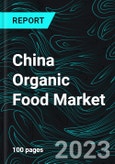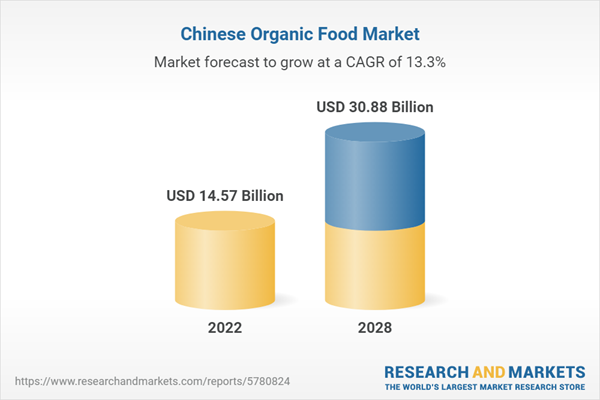China Organic Food Market Size will reach US$ 30.88 Billion by 2028
China Organic Food Market Size will reach US$ 30.88 Billion by 2028 compared to US$ 14.57 Billion in 2022, as per the publisher. As the fourth largest organic market in the world and the first in Asia, China is an increasingly important buyer of organic products. Looking at the evolution of the market, organic food in China has huge potential in international and domestic markets. Most Chinese consumers are price sensitive and look for value when buying organic food. China's demand for Organic Food has grown at a fast pace in the past decade. In the next decade, both production and demand will continue to grow. The Chinese economy maintains a high speed growth which has been stimulated by the consecutive increases of industrial output, imports & exports, consumer consumption and capital investment for over two decades.
China Organic Food Industry will grow at a CAGR of 13.34% during 2022-2028
Organic farming continues to show a rapid development world-wide. China is one of the world’s largest agriculture producers and consumer of the agriculture products. Agriculture is one of the most important economic sectors in China, which employs over 295 million Chinese farm workers. Despite the agricultural output is the largest in the world, less than 7% of the world land area can be cultivated, which fed over 18% of the world population, in 2023.
China ranks the first in worldwide agricultural producer of rice, and principal sources of wheat, corn, tobacco, soybeans, peanuts, cotton, potatoes, sorghum, peanuts, tea, dairy, millet, barley, oilseed, pork and fish which provide China with a small portion of its foreign trade revenue. The main factors driving the purchase of organic products, also during the pandemic, reflect the attention of Chinese consumers towards physical health, food safety and its benefits on the maintenance of a healthy physical condition. More than 2.95 million hectares of land were farmed organically at the end of 2022 in China. Moreover, a series of food scandals occurred in China over the last years, emphasized the shift of interest of Chinese consumers towards foreign imported products, even at higher prices, better satisfy consumers’ needs in terms of quality and safety.
Organic Food Production Models in China: the System Production is the main Force
In China, most organic foods are cultivated by organized systems, not like other countries where organic foods are supplied by individuals. There are three main organic food production models in China: the first one is that big company leases land from farmer and pays them. The second model is that under the permission of local governments, big companies sign an organic food production contract with farmers. The third one is the organic producer association. Farmers set up an association by themselves to conduct large-scale organic food production.
Organic Dairy Industry in China has been growing steadily in recent years, driven by increasing demand for Healthy and Safe Food Products
Based on China Organic Food segment, organic dairy accounts for the majority of the market share. China is becoming one of the largest organic dairy consumers in the world. The increasing demand for organic dairy products in China can be attributed to several factors, including the rising awareness about the use of fertilizers, pesticides, and bovine growth hormone in conventional dairy farming practices, which has led consumers to opt for healthier and organic products.
These products are known to have higher levels of beneficial nutrients such as vitamins, omega-3 fatty acids, antioxidants, and conjugated linoleic acid (CLA). Additionally, the growth of the organic dairy market in China is being driven by factors such as rapid urbanization, rising disposable incomes, and concerns about food safety due to widespread food adulteration practices in the country.
China's organic fresh products industry, which includes fruits, vegetables, meat, poultry, and seafood, has experienced significant growth in recent years due to increasing demand for healthy and safe food products, as well as rising awareness of environmental sustainability and animal welfare concerns among consumers. Organic fruits and vegetables are particularly popular, accounting for over 70% of the market share.
Consumers are willing to pay a premium for organic products that are free from harmful pesticides, herbicides, and synthetic fertilizers, driven by health consciousness, food safety, and environmental sustainability concerns. The Chinese government has been promoting the industry's development by providing subsidies for organic farming and certification and encouraging sustainable agriculture practices.
Chinese Supermarkets' Organic Food Market is expected to grow as Chinese Consumers Continue to demand Healthy, Safe, and Sustainable Food Products
On the basic of Distribution, China Organic Food industry has been divided into Hypermarkets, Supermarkets, Independent Small Grocers, Internet Retailing, Direct Selling, Forecourt Retailers and Others Grocery Retailers. In China, the market for organic food products in supermarkets has experienced significant growth in recent years, fueled by consumers' heightened health awareness, rising disposable incomes, and growing concerns over the environmental and health impacts of conventional food production methods. Leading supermarkets in the country, including Walmart, Carrefour, and Alibaba'sHema Fresh, have responded to the increasing demand for organic products by expanding their offerings.
China is by far the largest Internet Retailing market in the world. Thus, online retail and O2O models are the most efficient sales channels for organic food in China. As the largest consumer market for organic packaged foods and beverages and the fastest growing organic food market in Asia, China’s organic market offers many opportunities for foreign B2B investors. Geographically, the consumption of organic products is mainly concentrated within the high-tier cities, therefore big cities as Peking, Shanghai, Guangzhou, identifying the upper class as the main destination target. Moreover, online grocery shopping platforms like JD.com and Taobao have also entered the market, making organic food products more convenient and accessible to consumers.
Key Company
The report profiles several key market players in the industry, including China Mengniu Dairy Company Limited, Abbot China, Ausnutria Dairy (China) Company Ltd, TINGYI (CAYMAN ISLANDS) HOLDING CORP, and WH Group Limited.
The report titled “China Organic Food Market by Segments (Organic Baby Formula, Organic Baby Food, Organic Dairy , Organic Oils & Fats , Organic Beverages and Organic Fresh Products), Distribution Models (Hypermarkets, Supermarkets, Independent Small Grocers, Internet Retailing, Direct Selling, Forecourt Retailers and Others Grocery Retailers), Company (China Mengniu Dairy Company Limited, Abbot China, Ausnutria Dairy (China) Company Ltd, TINGYI (CAYMAN ISLANDS) HOLDING CORP, and WH Group Limited.)” provides a complete analysis of Chinese Organic Food Industry.
Segments - Market Breakup from 6 viewpoints
1. Organic Baby Formula
2. Organic Baby Food
3. Organic Dairy
4. Organic Oils & Fats
5. Organic Beverages
6. Organic Fresh Products
Distribution Models - Market Breakup from 7 viewpoints
1. Hypermarkets
2. Supermarkets
3. Independent Small Grocers
4. Internet Retailing
5. Direct Selling
6. Forecourt Retailers
7. Others Grocery Retailers
All companies have been covered from 3 viewpoints
- Overviews
- Recent Developments
- Revenues
Company
1. China Mengniu Dairy Company Limited
2. Abbot China
3. Ausnutria Dairy (China) Company Ltd
4. TINGYI (CAYMAN ISLANDS) HOLDING CORP
5. WH Group Limited
Table of Contents
Companies Mentioned
- China Mengniu Dairy Company Limited
- Abbot China
- Ausnutria Dairy (China) Company Ltd
- TINGYI (CAYMAN ISLANDS) HOLDING CORP
- WH Group Limited
Methodology
In this report, for analyzing the future trends for the studied market during the forecast period, the publisher has incorporated rigorous statistical and econometric methods, further scrutinized by secondary, primary sources and by in-house experts, supported through their extensive data intelligence repository. The market is studied holistically from both demand and supply-side perspectives. This is carried out to analyze both end-user and producer behavior patterns, in the review period, which affects price, demand and consumption trends. As the study demands to analyze the long-term nature of the market, the identification of factors influencing the market is based on the fundamentality of the study market.
Through secondary and primary researches, which largely include interviews with industry participants, reliable statistics, and regional intelligence, are identified and are transformed to quantitative data through data extraction, and further applied for inferential purposes. The publisher's in-house industry experts play an instrumental role in designing analytic tools and models, tailored to the requirements of a particular industry segment. These analytical tools and models sanitize the data & statistics and enhance the accuracy of their recommendations and advice.
Primary Research
The primary purpose of this phase is to extract qualitative information regarding the market from the key industry leaders. The primary research efforts include reaching out to participants through mail, tele-conversations, referrals, professional networks, and face-to-face interactions. The publisher also established professional corporate relations with various companies that allow us greater flexibility for reaching out to industry participants and commentators for interviews and discussions, fulfilling the following functions:
- Validates and improves the data quality and strengthens research proceeds
- Further develop the analyst team’s market understanding and expertise
- Supplies authentic information about market size, share, growth, and forecast
The researcher's primary research interview and discussion panels are typically composed of the most experienced industry members. These participants include, however, are not limited to:
- Chief executives and VPs of leading corporations specific to the industry
- Product and sales managers or country heads; channel partners and top level distributors; banking, investment, and valuation experts
- Key opinion leaders (KOLs)
Secondary Research
The publisher refers to a broad array of industry sources for their secondary research, which typically includes, however, is not limited to:
- Company SEC filings, annual reports, company websites, broker & financial reports, and investor presentations for competitive scenario and shape of the industry
- Patent and regulatory databases for understanding of technical & legal developments
- Scientific and technical writings for product information and related preemptions
- Regional government and statistical databases for macro analysis
- Authentic new articles, webcasts, and other related releases for market evaluation
- Internal and external proprietary databases, key market indicators, and relevant press releases for market estimates and forecasts

LOADING...
Table Information
| Report Attribute | Details |
|---|---|
| No. of Pages | 100 |
| Published | April 2023 |
| Forecast Period | 2022 - 2028 |
| Estimated Market Value ( USD | $ 14.57 Billion |
| Forecasted Market Value ( USD | $ 30.88 Billion |
| Compound Annual Growth Rate | 13.3% |
| Regions Covered | China |
| No. of Companies Mentioned | 5 |









